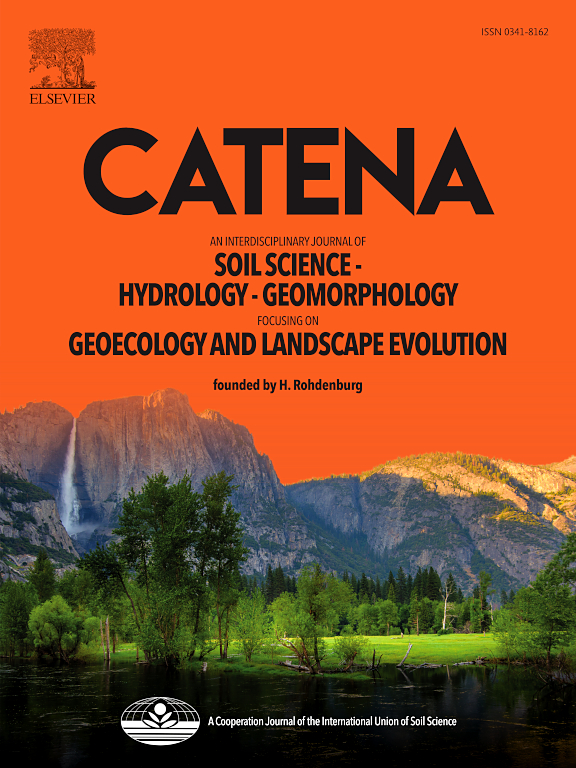Drivers of soil organic carbon stocks at village scale in a sub-humid region of Zimbabwe
IF 5.7
1区 农林科学
Q1 GEOSCIENCES, MULTIDISCIPLINARY
引用次数: 0
Abstract
Land use change caused by agriculture and inappropriate agricultural management cause soil organic carbon (SOC) loss. This study was conducted in a smallholder communal area of Zimbabwe with the following objectives: i) to quantify SOC stocks under contrasting land uses and soil types, and estimate landscape-level SOC stocks, ii) to assess the impact of historical agricultural management parctices on SOC in croplands (homefields vs outfields), and iii) to estimate temporal changes in SOC stocks due to land use change using field measurements and geospatial data (Africa Soil Information Service, AfSIS). SOC stocks were measured across three soil types and eight land uses (croplands, gardens, fallows, grasslands, vleis, shrublands, forests and tree plantations) at soil depths of 0–20 and 20–40 cm. Estimates from AfSIS were also used for comparison. SOC stocks were highest on black clay soils (66.9 ± 2.30 Mg C/ha), followed by red clay soils (36.1 ± 2.04 Mg C/ha) and sandy soils (25.5 ± 0.59 Mg C/ha). Among land uses, SOC stocks were highest in vleis (67.9 ± 3.55 Mg C/ha), followed by gardens (56.4 ± 2.34 Mg C/ha) and grasslands (53.1 ± 6.18 Mg C/ha). Croplands on sandy soils had the lowest stocks (22.7 ± 0.77 Mg C/ha). Distance from homestead had no significant effect on SOC stocks. SOC stocks estimated by AfSIS were systematically underestimated in vleis, grasslands and gardens, resulting in a 20 % underestimation of landscape SOC stocks. Landscape SOC stocks declined slightly (−0.2 %) from 2002 to 2023, though the change was not statistically significant. Our findings highlight that SOC stocks hotspots are concentrated in vleis, gardens and grasslands, mostly within communal grazing lands. Their conservation should therefore be a priority, emphasizing the need for collective management. On the other hand, restoration of degraded croplands could be enhanced by strenghtening linkages between cultivated fields and communal grazing lands through improved livestock management.

津巴布韦半湿润地区村庄尺度土壤有机碳储量的驱动因素
农业引起的土地利用变化和不当的农业管理导致土壤有机碳(SOC)流失。本研究在津巴布韦的一个小农公共地区进行,目的如下:1)在对比土地利用和土壤类型的情况下量化土壤有机碳储量,并估算景观水平的土壤有机碳储量;2)评估历史农业管理实践对农田(家庭田与野外田)有机碳储量的影响;3)利用野外测量和地理空间数据(非洲土壤信息服务,AfSIS)估算土地利用变化导致的土壤有机碳储量的时间变化。在土壤深度为0-20 cm和20-40 cm的土壤中,测量了3种土壤类型和8种土地利用方式(农田、花园、休耕、草地、沼泽、灌丛、森林和人工林)的有机碳储量。AfSIS的估计也用于比较。有机碳储量最高的是黑粘土(66.9±2.30 Mg C/ha),其次是红粘土(36.1±2.04 Mg C/ha)和沙土(25.5±0.59 Mg C/ha)。土壤有机碳储量以草地最高(67.9±3.55 Mg C/ha),其次为园林(56.4±2.34 Mg C/ha)和草地(53.1±6.18 Mg C/ha)。沙质土壤的储量最低(22.7±0.77 Mg C/ha)。距离对土壤有机碳储量影响不显著。利用AfSIS估算的土壤有机碳储量在农田、草地和园林中被系统性低估,导致景观土壤有机碳储量被低估20%。从2002年到2023年,景观有机碳储量略有下降(- 0.2%),但变化不显著。研究结果表明,土壤有机碳储量的热点地区主要集中在农田、园林和草地,且以公共放牧地为主。因此,它们的养护应是一项优先事项,强调集体管理的必要性。另一方面,通过改善牲畜管理,加强耕地和公共放牧地之间的联系,可以促进退化耕地的恢复。
本文章由计算机程序翻译,如有差异,请以英文原文为准。
求助全文
约1分钟内获得全文
求助全文
来源期刊

Catena
环境科学-地球科学综合
CiteScore
10.50
自引率
9.70%
发文量
816
审稿时长
54 days
期刊介绍:
Catena publishes papers describing original field and laboratory investigations and reviews on geoecology and landscape evolution with emphasis on interdisciplinary aspects of soil science, hydrology and geomorphology. It aims to disseminate new knowledge and foster better understanding of the physical environment, of evolutionary sequences that have resulted in past and current landscapes, and of the natural processes that are likely to determine the fate of our terrestrial environment.
Papers within any one of the above topics are welcome provided they are of sufficiently wide interest and relevance.
 求助内容:
求助内容: 应助结果提醒方式:
应助结果提醒方式:


